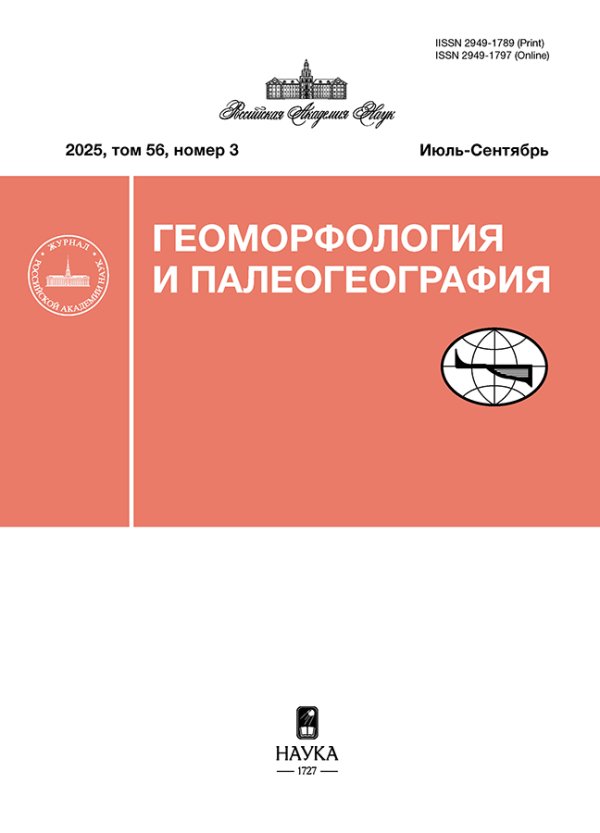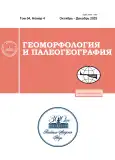MINERAL COMPOSITION AND FORMATION CONDITIONS OF BOTTOM SEDIMENTS OF THE SMALL LAKES IF THE UKOK PLATEAU (ALTAI)1
- Authors: Strahovenko V.D.1, Malov G.I.1, Ovdina E.A.1, Malov V.I.1
-
Affiliations:
- Sobolev Institute of Geology and Mineralogy SB RAS
- Issue: Vol 54, No 4 (2023)
- Pages: 207-225
- Section: Paleolimnological research in Russia: from Kaliningrad to Kamchatka
- URL: https://journals.rcsi.science/2949-1789/article/view/232948
- DOI: https://doi.org/10.31857/S2949178923040138
- EDN: https://elibrary.ru/GMDPBK
- ID: 232948
Cite item
Full Text
Abstract
Numerous modern lakes appeared in the intermountain basins and on the high-elevation plateaus of Altai within the immediate distribution of glaciation in the Neo-Pleistocene. There is little known about the geochemical processes of autigenic mineral formation in lake systems under conditions of nival sedimentogenesis. The study of cores of bottom sediments of 8 high-altitude lakes of Altai showed that the waters of the lakes are fresh bicarbonate with variations in the cationic composition of Ca–Na. The bottom sediments of lakes are characterized by different ratios of mineral detrital material, autigenic minerals (calcite, gypsum, pyrite, illite) and mortmass of plant residues. In the bottom sediments of lakes located within the same basin (Bertek or Tarkhatinskaya), the absolute concentrations of elements differ within one standard deviation, with the exception of significant variations in the contents of individual elements (Mo, U, Li, Be). The enrichment of bottom sediments of lakes (Argamdzhi, Teply Klyuch, Krasnoe) with these elements is associated with the presence of ore concentrations (Mo, U, Li, Be) in the local catchment areas of a single lake. The mineral associations of the sediments of the studied lakes differ from each other in the composition of autigenic minerals, and from rocks, soils of catchment areas in the composition of layered silicates. In the composition of fine-scaled, tangled fibrous aggregates of the bottom sediment illite, the amount of iron is 2-4 times greater than in the composition of lamellar aggregates of micas, chlorites from rocks, soils of catchment areas. Cryogenic processes have determined the crystallization of gypsum nodules in the lakes Argamdzhi and Small Tarkhatinskoye; and calcite aggregates in Zerlyukol-Nur and Large Tarkhatinskoye in significant volumes for lakes with fresh water composition.
About the authors
V. D. Strahovenko
Sobolev Institute of Geology and Mineralogy SB RAS
Author for correspondence.
Email: strahova@igm.nsc.ru
Russia, Novosibirsk
G. I. Malov
Sobolev Institute of Geology and Mineralogy SB RAS
Email: strahova@igm.nsc.ru
Russia, Novosibirsk
E. A. Ovdina
Sobolev Institute of Geology and Mineralogy SB RAS
Email: strahova@igm.nsc.ru
Russia, Novosibirsk
V. I. Malov
Sobolev Institute of Geology and Mineralogy SB RAS
Email: strahova@igm.nsc.ru
Russia, Novosibirsk
References
- Alifanov V.M., Gugalinskaya L.A. (2005). Paleohydromorphism, paleocryogenesis, and morpholithopedogenesis of chernozems. Eurasian Soil Sci. Vol. 38. No. 3. P. 272–277.
- Andreychuk V.N., Kadebskaya O.I., Chaykovskii I.I. (2013). Kriogennye mineral’nye obrazovaniya Kungurskoi Ledyanoi peshchery (Cryogenic mineral formations of the Kungur Ice Cave). Sosnovets–Perm’: Silezskii universitet (Publ.). 128 p. (in Russ.)
- Annikova I.Yu., Vladimirov A.G., Vystavnoi S.A. et al. (2004). Geological and geophysical model of the formation of the Kalguta ore-magmatic system (Southern Altai). Izvestiya TPU. Vol. 307. No. 4. P. 38–42. (in Russ.)
- Badu Yu.B. (Ed.). (2021). Kriolitogenez. Priznaki i prizraki kriolitosfery (Cryolithogenesis. Signs and Ghosts of the Cryolithosphere). Moscow: Moscow University (Publ.). 368 p.
- Borodavko P.S. (2009). Quaternary evolution of the Altay Mountains lakes systems. Zhurnal SFU. Ser.: Biologiya. Iss. 1. No. 2. P. 18–29. (in Russ.)
- Dolgushin S.S. (Ed.). (2009). Geologicheskaya karta: M-45-XXIII, XXIX. Geologicheskaya karta Rossiiskoi Federa-tsii. Izdanie vtoroe. Seriya Gorno-Altaiskaya m-ba 1:200 000 (Geological map: M-45-XXIII, XXIX. Geological map of the Russian Federation. Second edition. Gorno-Altai series, scale 1 200 000). Moscow: Rosnedra (Publ.). 1 p. (in Russ.)
- Dolgushin S.S. (Ed.). (2009). Karta chetvertichnykh otlozhenii: M-45-XXIII, XXIX. Geologicheskaya karta Rossiiskoi Federatsii. Izdanie vtoroe. Karta chetvertichnykh obrazovanii. Seriya Gorno-Altaiskaya m-ba 1:200 000 (Map of Quaternary deposits: M-45-XXIII, XXIX. Geological map of the Russian Federation. Se-cond edition. Map of Quaternary formations. Gorno-Altai series, scale 1:200 000). Moscow: Rosnedra (Publ.). 1 p. (in Russ.)
- GOST 31861-2012. Voda. Obshchiye trebovaniya k otboru prob (GOST 31861-2012. Water. General Sampling Requirements). (2013). Moscow: Standartinform (Publ.). 31 p. (in Russ.)
- Fedak S.I., Turkin Yu.A., Gusev A.I. et al. (2011). Gosudarstvennaya geologicheskaya karta Rossiiskoi Fede-ratsii. Masshtab 1:1 000 000 (tret’e pokolenie). Seriya Altae-Sayanskaya. List M-45 – Gorno_Altaisk. Ob"yasnitel’naya zapiska (State Geological Map of the Russian Federation. Scale 1:1 000 000 (third generation). Altai-Sayan series. Sheet M-45 – Gorno_Altaysk. Explanatory letter.) Saint Petersburg: Kartograficheskaya fabrika VSEGEI (Publ.). 567 p. (in Russ.)
- Fotiev S.M. (2009). Kriogennyi metamorfizm porod i podzemnykh vod (usloviya i rezul’taty) (Cryogenic metamorphism of rocks and groundwater (conditions and results)). Novosibirsk: GEO (Publ.). 279 p. (in Russ.)
- Fotiev S.M. (2020). Debatable problems of geocryology: review of achievements. Earth’s cryosphere. Vol. XXIV. No. 3. P. 3–15. https://doi.org/10.21782/EC2541-9994-2020-3(3-15)
- Ganyushkin D.A., Chistyakov K.V., Volkov I.V. et al. (2017). Modern data on glaciation of the northern slope of Tavan-Bogdo-Ola massif (Altai). Ice and Snow. Vol. 57. No. 3. P. 307–325. (in Russ.) https://doi.org/10.15356/2076-6734-2017-3-307-325
- Gerasimova M.I., Lebedeva I.I., Khitrov N.B. (2013). Indexation of soil horizons: state of the problem, problems and suggestions. Soil Science. No. 5. P. 627–638.
- Ivanov A.V. (1998). Kriogennaya metamorfizatsiya khimi-cheskogo sostava prirodnykh l’dov, zamerzayushchikh i talykh vod (Cryogenic metamorphization of the che-mical composition of natural ice, freezing and melt waters). Khabarovsk: Dal’nauka (Publ.). 164 p. (in Russ.)
- Kalugin I., Daryin A., Smolyaninova L. et al. (2007). 800 year long annual records of air temperature and precipitation over Southern Siberiainferred from high-resolution time-series of Teletskoye Lake sediments. Quat. Res. Vol. 67. Iss. 3. P. 400–410. https://doi.org/10.1016/j.yqres.2007.01.007
- Konishchev V.N. (1998). The ratio of cryogenic and non-cryogenic factors of hypergenesis in the permafrost area. Vestn. Mosk. Un-ta. Ser. 5. Geografiya. No. 1. P. 8–14. (in Russ.)
- Konishchev V.N., Lebedeva-Verba M.P., Rogov V.V., Stalina E.E. (2006). Kriogenez sovremennykh i pozdnepleistotsenovykh otlozhenii Altaya i pereglyatsial’nykh oblastei Evropy (Cryogenesis of modern and late Pleistocene deposits of Altai and transglacial regions of Europe). Moscow: GEOS (Publ.). 128 p. (in Russ.)
- Lozovik P.A., Efremenko N.A. (Eds.). (2017). Analiticheskie, kineticheskie i raschetnye metody v gidrokhimi-cheskoi praktike (Analytical, kinetic and computational methods in hydrochemical practice). St. Petersburg: Nestor-History (Publ.). 272 p. (in Russ.)
- Maslov V.I., Kozlov M.S., Dovgal’ V.N. et al. (1994). Complex of ongonites and lithium fluoride granites of southwestern Altai. Petrologiya. Vol. 2. No. 3. P. 331–336. (in Russ.)
- Mikhailov N.N. (1994). Lakes of Altai, their origin and history. Geografiya i prirodopol’zovanie Sibiri. No. 1. P. 75–89. (in Russ.)
- Mikhailov N.N. (1995). Altai. Istoriya ozer Severa Azii. Saint Petersburg: Nauka (Publ.). P. 249–262. (in Russ.).
- Okishev P.A. (2011). Rel’ef i oledenenie Russkogo Altaya (Relief and glaciation of the Russian Altai). Tomsk: TGU (Publ.). 382 p. (in Russ.)
- Panichev A.M., Baranovskaya N.V., Vakh E.A. (2022). New data on the chemical composition of the waters of the Dzhumalinsky geothermal spring, Gorny Altai, Russia. Polevye issledovaniya v Altaiskom biosfernom zapovednike. No. 4. P. 137–143. (in Russ.) https://doi.org/10.52245/26867109_2022_4_137
- Potseluev A.A., Babkin D.I., Kotegov V.I. (2006). Kalgutinskoe complex deposit (Gorny Altai): mineralogical and geochemical characteristics, fluid regime of ore formation. Geologiya rudnykh mestorozhdenii. Vol. 48. No. 5. P. 439–459. (in Russ.)
- Puzanov A.V., Baboshkina S.V., Balykin S.N. et al. (2020). Chemical elements in soils and surface waters of the Ukok plateau (south-eastern Altai). Izvestiya TPU. Inzhiniring georesursov. Iss. 331. No. 1. P. 34–43. (in Russ.). https://doi.org/10.18799/24131830/2020/1/2445
- Rengarten P.A. (Eds.). (1959). Geologicheskaya karta: M-45-XXII, XXVIII. Geologicheskaya karta SSSR. Seriya Gorno-Altaiskaya m-ba 1:200 000 (Geological map: M-45-XXII, XXVIII. Geological map of the USSR. Series Gorno-Altai scale 1 200 000). Moscow: Gosgeoltekhizdat (Publ.). 1 p. (in Russ.)
- Romanovskii N.N. (1993). Osnovy kriogeneza litosfery (Fundamentals of cryogenesis of the lithosphere). Moscow: Moskovskii universitet (Publ.). 334 p. (in Russ.)
- Rudoi A.N. (1980). On the genesis and age of banded deposits in the Bolshoi Ulagan valley (Gorny Altai). Voprosy geografii Sibiri. Vol. 13. Tomsk: Tomskii universitet (Publ.). P. 88–91. (in Russ.)
- Rudoi A.N., Lysenkova Z.V., Rudskii V.V. et al. (2000). Ukok (proshloe, nastoyashchee, budushchee) (Ukok (past, present, future)). Barnaul: Altaiskii gosudarstvennyi universitet (Publ.). 174 p. (in Russ.)
- Rusanov G.G. (2015). Optimum of the Holocene of the South-Eastern Altai on the example of the deposits of the high-mountainous Tarkhatinsky Lake. Izvestiya AO RGO. No. 1 (36). P. 81–85. (in Russ.)
- Savenko A.V., Savenko V.S., Pokrovsky O.S. (2020). New data on the concentrations of dissolved trace elements in waters of Russian Arctic rivers. Dokl. Earth Sci. Vol. 491. No. 2. P. 257–263. https://doi.org/10.1134/S1028334X20040169
- Sevast’yanov D.V., Mikhailov N.N. (1994). Lake comp-lexes of Gorny Altai and their evolution in the Holocene. Vestn. SPbGU. Ser. 7. Geologiya. Geografiya. No. 3. P. 59–68. (in Russ.)
- Selegey V.V., Selegey T.V. (1978). Teletskoye ozero (Teletskoye Lake). Leningrad: Hydrometeoizdat (Publ.). 142 p. (in Russ.)
- Sokolova E.N., Smirnov S.Z., Annikova I.Y. et al. (2011). Ongonite–elvan magmas of the Kalguty ore-magmatic system (Gorny Altai): composition, fluid regime, and genesis. Russian Geology and Geophysics. Vol. 52. No. 11. P. 1378–1400. https://doi.org/10.1016/j.rgg.2011.10.017
- Velichko A.A., Morozova T.D., Nechaev V.P. et al. (1996). Paleokriogenez, pochvennyi pokrov i zemledelie (Paleocryogenesis, soil cover and agriculture). Moscow: Nauka (Publ.). 150 p. (in Russ.)
- Wedepohl K.H. (1995). The composition of the continental crust. Geochim. Cosmochim. Acta. Vol. 59. No. 7. P. 1217–1232. https://doi.org/10.1016/0016-7037(95)00038-2
- Yaroshevskii A.A. (2004). Problemy sovremennoi geo-khimii: konspekt lektsii, prochitannyi v GEOKHI RAN v zimnem semestre 2003–2004 gg. (Problems of modern geochemistry: lecture notes given at GEOKHI RAS in the winter semester 2003–2004). Novosibirsk: NGU (Publ.). 194 p. (in Russ.)
- Yelchininova O.A., Puzanov A.V., Rozhdestvenskaya T.A. (2019). Physico-chemical properties and content of biogenic elements in mountain tundra soils of the Altai Mountains. Izvestiya AO RGO. Iss. 55. No. 4. P. 106–111. (in Russ.) https://doi.org/10.24411/2410-1192-2019-15512
- Zarubina E.Yu., Fetter G.V. (2022). Features of the formation of primary production and destruction of organic matter in the mountain lakes of the Russian Altai. Mat-ly IV Vseros. nauch. konf. s mezhdunar. uch. “Vodnye i ekologicheskie problemy Sibiri i Tsentral’noi Azii”, 29 avgusta – 3 sentyabrya 2022 g. T. 2. Barnaul: Pyat’ plyus (Publ.). P. 236–241. (in Russ.)
Supplementary files















